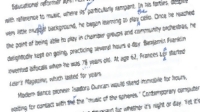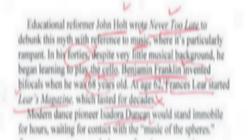| |
The M-Factors: Qualities that Help You Break Into Major Magazines
by Marcia Yudkin
While gathering material for my advanced magazine writing course, I spent several days in the periodical room of my public library, examining articles in top magazines, in search of the virtues that enable writers to entice and satisfy publishing's most selective editors.
Of course every magazine has a distinctive voice and particular story and style preferences, but the following five characteristics appeared to be widely valued. Increase your ability to deliver these qualities and you'll boost your success rates, prestige and pay at major magazines.
|
M-Factor #1: "High-concept" stories. These involve story angles destined to create a buzz or make issues fly off the newsstand because the story surprises or tantalizes. People in the target market can't help wanting to read the article after hearing or reading the idea. "High-concept" appeal might derive from:
- Catchy concept. Men's Journal had a cover story attempting to sum up the spirit of our era: "He who has the best time wins," illustrated by three guys pitching through white water on a raft. Similarly,
Fast Company had a cover story a while back called "Free Agent Nation," proposing a name for the growth in numbers of independent contractors in the U.S. Likewise, lots of magazines describe how to live longer, but
Modern Maturity labelled it "The Methuselah Factor."
|
|
Published! How to
Reach Writing Success
|
|
- Controversy. "Bottom-of-the-barrel public schools" for a city magazine, "Eliminate most hunting laws" for an environmental magazine or "The hidden virtues of HMO's" for a political magazine all have the power to startle their respective readerships and generate talk.
- Cutting-edge research. "Want to buy Internet stocks? Your teenager probably knows more about the Internet than your broker": This was a media-release headline that led to coverage on CNBC, CNN and other national broadcast stations, but it could just as well have been a cover line for
Money magazine. Compare "Stockbroker survey reveals Internet ignorance," which also fits the content of the story, but lacks that imaginative twist of bringing in the teenager.
To master this factor, study the teasers on magazine covers and for each article come-on that seems especially appealing, imagine a more pedestrian and less inventive version of the concept. Then reverse the process, imagining a straightforward topic and putting a creative spin on it. In addition, practice generating "high concepts" by copying a list of titles from covers of a particular magazine and then adding to the list yourself.
M-Factor #2: Depth of content. In contrast to one-dimensional, factual reporting, many of the major-magazine stories I examined offered some additional element that made the article more absorbing or admirable. This way, readers would come away from the piece not merely informed, but also educated, persuaded, spiritually enlightened or emotionally moved. Examples of the extra dimension:
- Education: In Martha Stewart Living, an article on capers treats readers to the cultural, historical, botanical, Biblical, culinary and medical aspects of this condiment. A
Sierra article called "Living with Floods" went deeply into the ecology of flood plains, complete with schematic diagrams. Typical readers of each of these pieces would emerge having learned quite a bit.
- Persuasion: I once heard an Atlantic Monthly editor state that they always prefer their writers to take a stand. That priority was evident in an article on the controversy over coffee-growing's impact on the environment, which came down on the side of "sustainable coffee." Likewise an
Atlantic article on Waldorf schools, where imagination gets as much attention as knowledge, was reverential even while mentioning criticisms. In Parents, an article announced on the cover with the question, "Should your children watch the news?" landed squarely on the "No" side of the issue.
- Enlightenment: This wouldn't work for every magazine, but in an article on creativity for
New Age Journal a number of years ago, I made a special effort to relate the piece to eternal themes, as in this conclusion: "For every human being always has the capacity to fashion something out of nothing. That's the God in us, as real as sky and blood. And perhaps that's why creativity gives us such a unique, unearthly buzz. When each visitation brings with it a taste of the infinite, no wonder that we yearn for more, and more, and more."
- Emotional involvement: An article in New Choices called "You CAN Go Home Again" intensified visceral reader identification with the theme by lacing other people's stories with the author's high-pitched personal vignettes. Similarly, a portrait of Las Vegas in
National Geographic Traveler demonstrated what the destination still means to visitors today through the author's reminiscences of going there with his gambler dad in the early sixties.
- Literary echoes: A New Republic article on the marketing of "social phobia" as a disease offered as garnish evocative quotes from Aldous Huxley's
Brave New World. In Field & Stream, an article on hypothermia began with reminiscences about the author having read Jack London's "To Build a Fire" at age ten. You may not be a novelist yourself, but with such allusions you borrow some literary impact.
Sometimes the major-magazine depth does not involve a single added element but the kind of value one normally finds in a book, compressed into a piece the length of a chapter. For instance, you can find tons of articles on Internet
dot.coms, but a cover story in
Worth magazine called "Rich.com: How to Build Your Own Web Business Before It's Too Late" distilled a profusion of success stories into twenty principles taking up just eight authoritative, anecdote-strewn pages.
M-Factor #3: Resonance with readers. A former writing student of mine broke into
Ladies Home Journal with a personal-experience piece about how she'd lost one hundred pounds and kept it off by coming to terms with having been sexually assaulted in her teens. The magazine told her the article generated more reader mail than any article they ran that year, and possibly ever. From her initial query the editors probably recognized the power of this story to hit home with women in their thirties and forties. But reader resonance doesn't occur only with personal-experience articles.
How-to articles, traditional reporting and think pieces can also produce intense emotional identification and response when they tune in perfectly to what readers deeply care about or most want to know. Readers respond because they get the feeling that the magazine knows and understands them. This leads to a sense of intimacy with the magazine, which in turn boosts subscription renewal rates. Sometimes the resonance comes from an often-overlooked subset of readers feeling recognized and acknowledged for the first time.
For instance, a Parenting article announced on the cover as "Discipline: How to Keep Your Cool" began this way: Here's a confession: I have hit my children. I was angry when I did it
- out of control, even. It scared my kids, and scared me too. It also filled me with shame." What conscientious parent wouldn't identify with this revelation? This article by Joyce Maynard included anecdotes from other parents and from parenting experts.
M-Factor #4: Dramatization of the non-dramatic. I was impressed by many of the top-notch business and science stories I looked at, which took normally dry subjects and created a compelling and illuminating article instead of boring readers. Techniques they used included:
- Making the people involved come alive on the page. Writers describe the main characters' physical appearance, manner, working environment, hobbies, personal history, idiosyncrasies and motives, which helps readers care about what these entrepreneurs, executives or scientists care about.
- Relating the esoteric to the familiar. An article in Worth tamed the abstract concept of medical savings accounts by, among other tactics, connecting the idea to a historical icon: "The basic notion was advocated by Ben Franklin (though, in his day, for fire insurance): Insure only the part of your risk you couldn't possibly pay for, self-insure the rest, and bank the premium savings in an interest-earning account."
- Making the most of irony. An article called "Faster than a Speeding Photon" in
Discover opened and closed with a man trying by night to find success as a country music songwriter and by day to disprove Einstein's theory of relativity. A profile in Boston magazine of a bank CEO highlighted the fact that the man once lived in an ashram in India.
- Using organizing metaphors. In Popular Science,
a writer discussed antibiotic bacteria in terms of the metaphor of counterintelligence warfare, using just enough original verbal twists to keep it out of the realm of
cliche. In
Bloomberg Personal Finance, an article called "Anatomy of a Startup" exploited the anatomical metaphor (muscles, bones, blood, lung capacity) from beginning to end to discuss business processes, using it for the illustrations as well.
|
Run Your Business From the Beach, Shangri-La or Anywhere
Got the urge to hit the
road? Discover tips, tools and strategies for continuing to bring in the moolah while vacationing, traveling, moving to a temporary location or living full-time in an RV.
This course resolves your "but what about..." concerns about taking off.
Be a Digital Nomad. |

Take Your Business on the
Road Course |
|
M-Factor #5: A distinctive voice.
Think of Dave Barry's overgrown adolescent persona;
Annie Dillard's lush descriptiveness; Tom Peters'
scolding enthusiasm; Miss Manners' stuffy edicts; Tom
Wolfe's garrulous fervor. Certain top magazines become
more interested in your work when you evolve a
personality in print so characteristic that an isolated
paragraph by you becomes recognizable as yours.
Voice encompasses not only writing style but also
attitudes. When you write with a distinctive voice,
readers feel they haven't merely absorbed information
but have been in contact with you. Readers also get a
clear picture of your likes and dislikes, your personal
habits, your age and background, even your physical
appearance.
How do you develop your voice? Usually
it develops on its own if you get out of your own way
and stop trying to sound like some other writer you
admire. But you can also stretch and experiment by
introducing new or unaccustomed elements into your
prose, such as occasional one-word sentences or a
sentence running breathlessly on for seven lines;
vocabulary, either slang or esoteric, you don't
ordinarily use; a different rhythm within sentences;
attitudes you've never felt free to express; an
alternative kind of imagery; a certain volume and
emotional pitch, such as quiet and elegant or loud and
insistent.
You needn't get trapped in it when you find a voice you
like, that feels like you and that editors and readers
respond to. I have one friendly voice for how-to
writing, a more intimate one for personal essays and a
philosophical/informative one for journalistic
reporting. To keep my love affair with writing alive,
every once in a while I deliberately inject a new
element into my work, such as shorter sentences, more
humor or spiritual overtones.
Although I've been writing for highly visible
publications since 1981, I found my foray into the
periodical room illuminating and motivating. If you
don't have a wide reading diet of magazines, I highly
recommend such study. Regardless of your writing
experience, deciding to improve your skill with these
five aspects of writing will help you break into the big
time.
Copyright 2001 Marcia Yudkin.
All rights reserved.
 |
Improve Your
Proofreading
Quick online course teaches how to
catch pesky typos. Whether you check
writing on screen or on paper, learn the
stakes for error-ridden copy, the five
best proofreading methods and the tools
you can or shouldn't use to identify
errors. Includes practice tests and
answers.
Proofreading Hacks course. |
|








